MENU
The Electronic Scholarly Publishing Project: Providing access to classic scientific papers and other scholarly materials, since 1993. More About: ESP | OUR CONTENT | THIS WEBSITE | WHAT'S NEW | WHAT'S HOT
Comparative Timelines
The ESP Timeline (one of the site's most popular features) has been completely updated to allow the user to select (using the timeline controls above each column) different topics for the left and right sides of the display.
Select:
New Left Column
New Left Column
Dates
Decade
New Right Column
New Right Column
 Louis Agassiz attacks Darwin's the origin of species, rejecting the idea of evolution of the species and arguing that each species was created separately.
Louis Agassiz attacks Darwin's the origin of species, rejecting the idea of evolution of the species and arguing that each species was created separately.
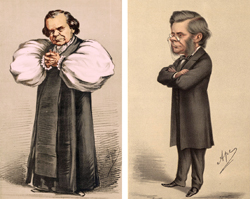 Thomas Henry Huxley (sometimes known as Darwin's bulldog) clashes with Bishop "Soapy Sam" Wilberforce about evolution at the annual meeting of The British Association for the Advancement of Science, in what has come to be known as the Huxley-Wilberforce debate.
Thomas Henry Huxley (sometimes known as Darwin's bulldog) clashes with Bishop "Soapy Sam" Wilberforce about evolution at the annual meeting of The British Association for the Advancement of Science, in what has come to be known as the Huxley-Wilberforce debate.
Bishop Wilberforce is supposed to have asked Huxley sarcastically whether "it was through his grandfather or his grandmother that he claimed descent from a monkey." Huxley responded, "If then the question is put to me whether I would rather have a miserable ape for a grandfather or a man highly endowed by nature and possessed of great means of influence and yet employs these faculties and that influence for the mere purpose of introducing ridicule into a grave scientific discussion, I unhesitatingly affirm my preference for the ape." Or words to that effect.
1860
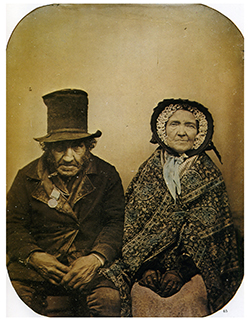 "A Veteran with his Wife", taken by an anonymous photographer, shows a British veteran of the Napoleonic era Peninsular Wars. It is a hand-tinted ambrotype using the set collodion positive process, made circa 1860.
"A Veteran with his Wife", taken by an anonymous photographer, shows a British veteran of the Napoleonic era Peninsular Wars. It is a hand-tinted ambrotype using the set collodion positive process, made circa 1860.
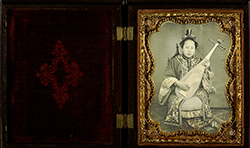 Daguerreotype by Unknown Photographer: Portrait of a Woman with a Mandolin. Collection of the J. Paul Getty Museum.
Daguerreotype by Unknown Photographer: Portrait of a Woman with a Mandolin. Collection of the J. Paul Getty Museum.
On December 20, South Carolina secedes from the union, setting in motion the forces leading to the US Civil war.
Southern Secession South Carolina secedes in December. More states follow the next year.
The Pony Express begins cross-country mail delivery.
John Phillips diagrams the progressive but fluctuating diversity of life on Earth based on the fossil record. His work evidences massive extinctions at the end of the Paleozoic and Mesozoic, and increased diversity in each subsequent age.
 Louis Pasteur becomes significantly involved in biological research with the publication of "Mémoir sur la fermentation alcoolique" in which he showed that alcoholic fermentation seemed to be carried out by yeast, which were themselves living organisms.
Louis Pasteur becomes significantly involved in biological research with the publication of "Mémoir sur la fermentation alcoolique" in which he showed that alcoholic fermentation seemed to be carried out by yeast, which were themselves living organisms.
Herman Hollerith was born 29th February 1860
 Emil Erlenmeyer invents the flask.
Emil Erlenmeyer invents the flask.

 Between 1861 and 1862, Max Johann Sigismund Schultze (Germany) and Heinrich Anton de Bary (Germany) establish the essential unity of protoplasm in all living cells.
Between 1861 and 1862, Max Johann Sigismund Schultze (Germany) and Heinrich Anton de Bary (Germany) establish the essential unity of protoplasm in all living cells.
1861
 Abraham Lincoln becomes sixteenth president of the United States.
Abraham Lincoln becomes sixteenth president of the United States.
Fort Sumter shelled, American Civil War begins.
The First Battle of Bull Run, also known as the First Battle of Manassas (the name used by Confederate forces and still often used in the Southern United States), is fought on July 21, 1861, near Manassas, Virginia. It is the first major land battle of the American Civil War. Neither Confederate nor Union troops were ready for battle. Union troops advanced on Confederate troops, almost breaking through, but at the last moment, Confederate reinforcements arrived on the battlefield and carried the day. Union troops were routed. Union civilian spectators, who had come to watch the expected Confederate defeat as entertainment, were forced to run for their lives.
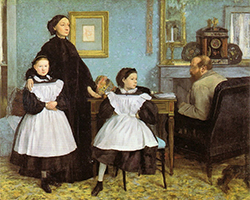 Painting by Edgar Degas: The Bellelli Family, also known as Family Portrait, is housed in the Musée d'Orsay. A masterwork of Degas' youth, the painting is a portrait of his aunt, her husband, and their two young daughters. While finishing his artistic training in Italy, Degas drew and painted his aunt Laura, her husband the baron Gennaro Bellelli, and their daughters Giulia and Giovanna. Although it is not known for certain when or where Degas executed the painting, it is believed that he utilized studies done in Italy to complete the work after his return to Paris. Laura, his father's sister, is depicted in a dress which symbolizes mourning for her father, who had recently died and appears in the framed portrait behind her. Laura Bellelli's countenance is dignified and austere, her gesture connected with those of her daughters. Her husband, by contrast, appears to be separated from his family. His association with business and the outside world is implied by his position at his desk. Giulia holds a livelier pose than that of her sister Giovanna, whose restraint appears to underscore the familial tensions.
Painting by Edgar Degas: The Bellelli Family, also known as Family Portrait, is housed in the Musée d'Orsay. A masterwork of Degas' youth, the painting is a portrait of his aunt, her husband, and their two young daughters. While finishing his artistic training in Italy, Degas drew and painted his aunt Laura, her husband the baron Gennaro Bellelli, and their daughters Giulia and Giovanna. Although it is not known for certain when or where Degas executed the painting, it is believed that he utilized studies done in Italy to complete the work after his return to Paris. Laura, his father's sister, is depicted in a dress which symbolizes mourning for her father, who had recently died and appears in the framed portrait behind her. Laura Bellelli's countenance is dignified and austere, her gesture connected with those of her daughters. Her husband, by contrast, appears to be separated from his family. His association with business and the outside world is implied by his position at his desk. Giulia holds a livelier pose than that of her sister Giovanna, whose restraint appears to underscore the familial tensions.
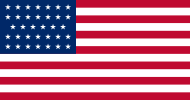 The US flag is modified to have thirty-four stars, reflecting the addition of one new state: Kansas.
The US flag is modified to have thirty-four stars, reflecting the addition of one new state: Kansas.
United States Civil War Four years of brutal conflict claim 623,000 lives.
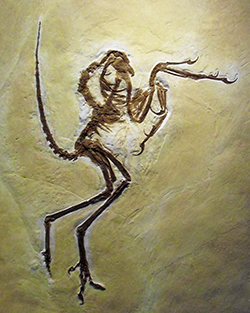 First recognized fossil Archaeopteryx lithographica skeleton is found in the stone quarries of Solnhofen.
First recognized fossil Archaeopteryx lithographica skeleton is found in the stone quarries of Solnhofen.
 In "Mémoires sur les corpuscles organisés qui existent dans l'atmosphère," Pasteur applies heat to bent-neck flasks to show unequivocally that the "organized bodies" (microbes) which drive fermentation originate from "organized bodies" that exist in the atmosphere. In this elegant series of experiments, Pasteur laid to rest the long-held belief in spontaneous generation."
In "Mémoires sur les corpuscles organisés qui existent dans l'atmosphère," Pasteur applies heat to bent-neck flasks to show unequivocally that the "organized bodies" (microbes) which drive fermentation originate from "organized bodies" that exist in the atmosphere. In this elegant series of experiments, Pasteur laid to rest the long-held belief in spontaneous generation."
In his presidential address to the Geological Society of London, Leonard Horner proposes removing the world's "creation" date of 4004 BC from the English Bible, citing geological evidence of a much older planet.
 Oliver Wendell Holmes invents stereoscope viewer
Oliver Wendell Holmes invents stereoscope viewer
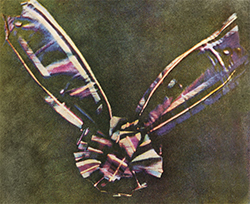 James Clerk Maxwell presents a projected additive color image of a multicolored ribbon, the first demonstration of color photography by the three-color method he suggested in 1855. It uses three separate black-and-white photographs taken and projected through red, green and blue color filters. The projected image is temporary but the set of three "color separations" is the first durable color photograph.
James Clerk Maxwell presents a projected additive color image of a multicolored ribbon, the first demonstration of color photography by the three-color method he suggested in 1855. It uses three separate black-and-white photographs taken and projected through red, green and blue color filters. The projected image is temporary but the set of three "color separations" is the first durable color photograph.
Congress passes the First Confiscation Act, which prevents Confederate slave owners from re-enslaving runaways.
(no entry for this year)
1862
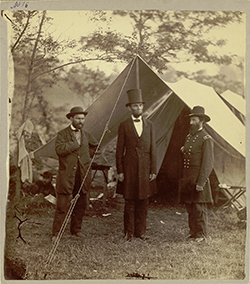 Photograph by Alexander Gardner: President Abraham Lincoln, Headquarters, Army of the Potomac, near Antietam, an albumen silver print. Allan Pinkerton stands to Lincoln's right, General John A. McClernand to Lincoln's left.
Photograph by Alexander Gardner: President Abraham Lincoln, Headquarters, Army of the Potomac, near Antietam, an albumen silver print. Allan Pinkerton stands to Lincoln's right, General John A. McClernand to Lincoln's left.
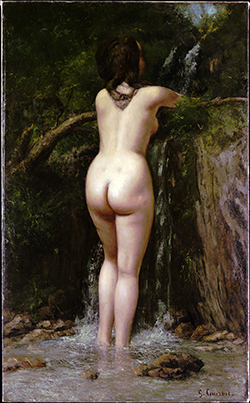 Painting by Gustave Courbet: The Source shows a nude in an unflinchingly naturalistic style and is devoid of the trappings of academic allegory to which the painting's title alludes. Courbet is thought to have intended it as a response to Ingres's own La Source (1856, Musée d Orsay, Paris), which was exhibited at the Galerie Martinet, Paris, in 1861. The picture by Ingres depicts an idealized nude holding a jar from which water pours, an allusion to a spring or river source, and symbolizing poetic inspiration.
Painting by Gustave Courbet: The Source shows a nude in an unflinchingly naturalistic style and is devoid of the trappings of academic allegory to which the painting's title alludes. Courbet is thought to have intended it as a response to Ingres's own La Source (1856, Musée d Orsay, Paris), which was exhibited at the Galerie Martinet, Paris, in 1861. The picture by Ingres depicts an idealized nude holding a jar from which water pours, an allusion to a spring or river source, and symbolizing poetic inspiration.
On April 16, Congress abolishes slavery in the District of Columbia.
 Otto von Bismarck is appointed Prime Minister of Prussia.
Otto von Bismarck is appointed Prime Minister of Prussia.
 The Battle of Fort Donelson (11-16 Feb) is an early Union victory in the American Civil War, which opened the Cumberland River as an avenue for the invasion of the South. The success elevated Brig. Gen. Ulysses S. Grant from an obscure and largely unproven leader to the rank of major general.
The Battle of Fort Donelson (11-16 Feb) is an early Union victory in the American Civil War, which opened the Cumberland River as an avenue for the invasion of the South. The success elevated Brig. Gen. Ulysses S. Grant from an obscure and largely unproven leader to the rank of major general.
The Battle of Shiloh (6-7 Apr). Although the Confederates swept the field on the first day, Union troops under U. S. Grant retook the field on the second day. Combined Union and Confederate casualties (23,746 killed, wounded, or missing) represented more than the total American battle-related casualties of the American Revolutionary War, the War of 1812, and the Mexican-American War combined.
Lord Kelvin asserts that the Earth and sun are cooling from their initial formation, between 20 and 400 million years ago. He will later adopt the smaller number.
Alfred Russel Wallace describes the "Wallace line," the dividing line between Indo-Malayan and Austro-Malayan fauna, in Proceedings of the Royal Geographical Society of London.

 Dominique Alexandre Godron and Charles Victor Naudin (France) independently report experiments in plant hybridization. Naudin confirmed Sageret's work, in general discussed work of the early hybridizers, and reported dominance and segregation in Datura (jimsonweed) hybrids. He did not deal with single characters and reported no statistical observations on the second generation. His theoretical explanation of his facts was a forerunner of Mendel's ideas, but inferred rather than deduced.
Dominique Alexandre Godron and Charles Victor Naudin (France) independently report experiments in plant hybridization. Naudin confirmed Sageret's work, in general discussed work of the early hybridizers, and reported dominance and segregation in Datura (jimsonweed) hybrids. He did not deal with single characters and reported no statistical observations on the second generation. His theoretical explanation of his facts was a forerunner of Mendel's ideas, but inferred rather than deduced.
1863
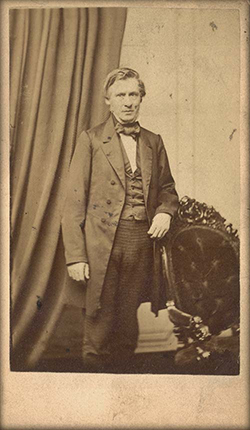 Photograph by John Adams Whipple: Asa Gray, an albumen print. Gray was considered the most important American botanist of the 19th century. His Darwiniana was considered an important explanation of how religion and science were not necessarily mutually exclusive. As a professor of botany at Harvard University for several decades, Gray regularly visited, and corresponded with, many of the leading natural scientists of the era, including Charles Darwin, who held great regard for him. Gray made several trips to Europe to collaborate with leading European scientists of the era, as well as trips to the southern and western United States. He also built an extensive network of specimen collectors.
Photograph by John Adams Whipple: Asa Gray, an albumen print. Gray was considered the most important American botanist of the 19th century. His Darwiniana was considered an important explanation of how religion and science were not necessarily mutually exclusive. As a professor of botany at Harvard University for several decades, Gray regularly visited, and corresponded with, many of the leading natural scientists of the era, including Charles Darwin, who held great regard for him. Gray made several trips to Europe to collaborate with leading European scientists of the era, as well as trips to the southern and western United States. He also built an extensive network of specimen collectors.
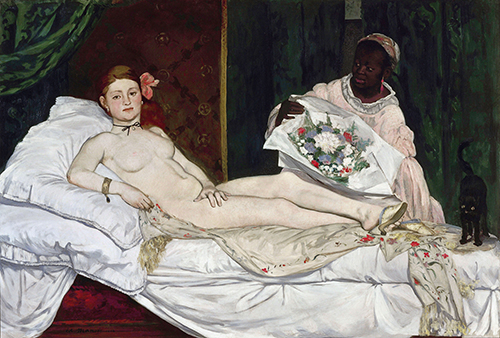 Painting by Édouard Manet: Olympia shocked the art world with its style (strong brush strokes, considered childish and unskilled) and its subject matter, a nude white woman ("Olympia"), presumably a courtesan, lying on a bed being brought flowers by a black servant. When hung in the Salon of Paris in 1865, it was met with jeers, laughter, criticism, and disdain, and was attacked by the public, the critics, the newspapers. Guards were stationed to protect it, until it was moved to a spot high above a doorway, out of reach.
Painting by Édouard Manet: Olympia shocked the art world with its style (strong brush strokes, considered childish and unskilled) and its subject matter, a nude white woman ("Olympia"), presumably a courtesan, lying on a bed being brought flowers by a black servant. When hung in the Salon of Paris in 1865, it was met with jeers, laughter, criticism, and disdain, and was attacked by the public, the critics, the newspapers. Guards were stationed to protect it, until it was moved to a spot high above a doorway, out of reach.
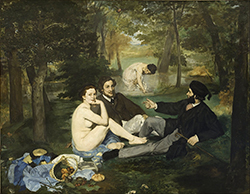 Painting by Édouard Manet: Le Déjeuner sur l'herbe (English: The Luncheon on the Grass) is a large oil on canvas painting depicting a female nude and a scantily dressed female bather on a picnic with two fully dressed men in a rural setting. Rejected by the Salon jury of 1863, Manet seized the opportunity to exhibit this and two other paintings in the 1863 Salon des Refusés where the painting sparked public notoriety and controversy. The piece is now in the Musée d'Orsay in Paris. A smaller, earlier version can be seen at the Courtauld Gallery, London. The painting features a nude woman casually lunching with two fully dressed men. Her body is starkly lit and she stares directly at the viewer. The two men, dressed as young dandies, seem to be engaged in conversation, ignoring the woman. In front of them, the woman's clothes, a basket of fruit, and a round loaf of bread are displayed, as in a still life. In the background, a lightly clad woman bathes in a stream. Too large in comparison with the figures in the foreground, she seems to float above them. The roughly painted background lacks depth — giving the viewer the impression that the scene is not taking place outdoors, but in a studio. This impression is reinforced by the use of broad "studio" light, which casts almost no shadows. The man on the right wears a flat hat with a tassel, of a kind normally worn indoors. Despite the mundane subject, Manet deliberately chose a large canvas size, measuring 81.9 by 104.1 inches, normally reserved for historical, religious, and mythological subjects. The style of the painting breaks with the academic traditions of the time. He did not try to hide the brush strokes; the painting even looks unfinished in some parts of the scene.
Painting by Édouard Manet: Le Déjeuner sur l'herbe (English: The Luncheon on the Grass) is a large oil on canvas painting depicting a female nude and a scantily dressed female bather on a picnic with two fully dressed men in a rural setting. Rejected by the Salon jury of 1863, Manet seized the opportunity to exhibit this and two other paintings in the 1863 Salon des Refusés where the painting sparked public notoriety and controversy. The piece is now in the Musée d'Orsay in Paris. A smaller, earlier version can be seen at the Courtauld Gallery, London. The painting features a nude woman casually lunching with two fully dressed men. Her body is starkly lit and she stares directly at the viewer. The two men, dressed as young dandies, seem to be engaged in conversation, ignoring the woman. In front of them, the woman's clothes, a basket of fruit, and a round loaf of bread are displayed, as in a still life. In the background, a lightly clad woman bathes in a stream. Too large in comparison with the figures in the foreground, she seems to float above them. The roughly painted background lacks depth — giving the viewer the impression that the scene is not taking place outdoors, but in a studio. This impression is reinforced by the use of broad "studio" light, which casts almost no shadows. The man on the right wears a flat hat with a tassel, of a kind normally worn indoors. Despite the mundane subject, Manet deliberately chose a large canvas size, measuring 81.9 by 104.1 inches, normally reserved for historical, religious, and mythological subjects. The style of the painting breaks with the academic traditions of the time. He did not try to hide the brush strokes; the painting even looks unfinished in some parts of the scene.
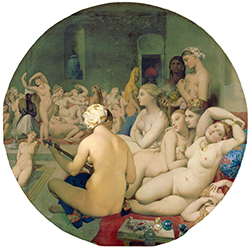 Painting by Jean Auguste Dominique Ingres: The Turkish Bath (Le Bain Turc) depicts a group of nude women in the bath of a harem, and is painted in a highly erotic style that evokes both the near east and earlier western styles associated with mythological subject matter. Painted on canvas laid down on wood, it measures 108 x 108 cm. The work is signed and dated 1862, when Ingres was around 82 years old, and was completed in 1863. In that year Ingres altered the painting's original rectangular format, and cut the painting to its present tondo form. Photographs of the painting in its original format survive. It seems based on an April 1717 written description of a Turkish harem by Lady Mary Montagu, where she mentions having viewed some two hundred nude women. The painting develops and elaborates a number of motifs Ingres had explored in earlier paintings, in particular his 1808 The Valpinçon Bather and Grande Odalisque of 1814. Its erotic content did not provoke a scandal, since for much its existence it has remained in private collections. It is now in the Louvre, Paris.
Painting by Jean Auguste Dominique Ingres: The Turkish Bath (Le Bain Turc) depicts a group of nude women in the bath of a harem, and is painted in a highly erotic style that evokes both the near east and earlier western styles associated with mythological subject matter. Painted on canvas laid down on wood, it measures 108 x 108 cm. The work is signed and dated 1862, when Ingres was around 82 years old, and was completed in 1863. In that year Ingres altered the painting's original rectangular format, and cut the painting to its present tondo form. Photographs of the painting in its original format survive. It seems based on an April 1717 written description of a Turkish harem by Lady Mary Montagu, where she mentions having viewed some two hundred nude women. The painting develops and elaborates a number of motifs Ingres had explored in earlier paintings, in particular his 1808 The Valpinçon Bather and Grande Odalisque of 1814. Its erotic content did not provoke a scandal, since for much its existence it has remained in private collections. It is now in the Louvre, Paris.
 Painting by Alexandre Cabanel: The Birth of Venus, now in the Musée d'Orsay in Paris. A second and smaller version (85 × 135.9 cm) from ca. 1864 is in Dahesh Museum of Art. A third (106 × 182.6 cm)[2] version dates from 1875; it is in the Metropolitan Museum of Art in New York City. Shown to great success at the Paris Salon of 1863, The Birth of Venus was immediately purchased by Napoleon III for his own personal collection. That same year Cabanel was made a professor of the Ecole des Beaux-Arts. Cabanel's combination of sensual and classical imagery appealed to the higher levels of society. Art historian and curator Robert Rosenblum wrote of Cabanel's The Birth of Venus that "This Venus hovers somewhere between an ancient deity and a modern dream"; he described "the ambiguity of her eyes, that seem to be closed but that a close look reveals that she is awake ... A nude who could be asleep or awake is specially formidable for a male viewer."
Painting by Alexandre Cabanel: The Birth of Venus, now in the Musée d'Orsay in Paris. A second and smaller version (85 × 135.9 cm) from ca. 1864 is in Dahesh Museum of Art. A third (106 × 182.6 cm)[2] version dates from 1875; it is in the Metropolitan Museum of Art in New York City. Shown to great success at the Paris Salon of 1863, The Birth of Venus was immediately purchased by Napoleon III for his own personal collection. That same year Cabanel was made a professor of the Ecole des Beaux-Arts. Cabanel's combination of sensual and classical imagery appealed to the higher levels of society. Art historian and curator Robert Rosenblum wrote of Cabanel's The Birth of Venus that "This Venus hovers somewhere between an ancient deity and a modern dream"; he described "the ambiguity of her eyes, that seem to be closed but that a close look reveals that she is awake ... A nude who could be asleep or awake is specially formidable for a male viewer."
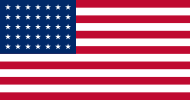 The US flag is modified to have thirty-five stars, reflecting the addition of one new state: West Virginia. This new state was created when Union sympathizers in the western portion of Virginia seceded from Virginia (then in secession from the US) and rejoined the Union.
The US flag is modified to have thirty-five stars, reflecting the addition of one new state: West Virginia. This new state was created when Union sympathizers in the western portion of Virginia seceded from Virginia (then in secession from the US) and rejoined the Union.
Abraham Lincoln's Emancipation Proclamation takes effect on January 1, legally freeing slaves in areas of the South still in rebellion against the United States.
 The Battle of Gettysburg (1-3 Jul) was the battle with the largest number of casualties in the American Civil War. Union Maj. Gen. George Gordon Meade's Army of the Potomac defeated attacks by Confederate Gen. Robert E. Lee's Army of Northern Virginia, ending Lee's invasion of the North.
The Battle of Gettysburg (1-3 Jul) was the battle with the largest number of casualties in the American Civil War. Union Maj. Gen. George Gordon Meade's Army of the Potomac defeated attacks by Confederate Gen. Robert E. Lee's Army of Northern Virginia, ending Lee's invasion of the North.

 The Siege of Vicksburg was the final major military action in the Vicksburg Campaign of the American Civil War. Union Maj. Gen. Ulysses S. Grant crossed the Mississippi River and drove the Confederate army of Lt. Gen. John C. Pemberton into the fortress city of Vicksburg, Mississippi, and placed the city under siege. After more than forty days, with no re-enforcement and supplies nearly gone, the garrison surrendered on July 4. This surrender, combined with Lee's defeat at Gettysburg the previous day, represents the turning point of the war. From then on, military victory for the Confederacy was impossible.
The Siege of Vicksburg was the final major military action in the Vicksburg Campaign of the American Civil War. Union Maj. Gen. Ulysses S. Grant crossed the Mississippi River and drove the Confederate army of Lt. Gen. John C. Pemberton into the fortress city of Vicksburg, Mississippi, and placed the city under siege. After more than forty days, with no re-enforcement and supplies nearly gone, the garrison surrendered on July 4. This surrender, combined with Lee's defeat at Gettysburg the previous day, represents the turning point of the war. From then on, military victory for the Confederacy was impossible.
Anti-evolutionist James Hunt, founder of the Anthropological Society of London, gives a presidential address to the society stating that human races were created separately. He further argues that the African species is closer in ability to apes than to Europeans.
T. H. Huxley publishes Man's Place in Nature discussing human and primate paleontology, and showing similarities between humans and other animals.
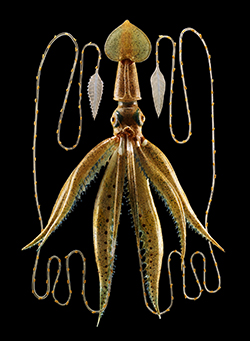 Father-and-son glassworkers Leopold and Rudolf Blaschka begin making glass models of marine invertebrates. Marine biologists will refer to their exquisitely detailed, accurate models 150 years later while trying to see how many of the depicted species can still be found in the wild.
Father-and-son glassworkers Leopold and Rudolf Blaschka begin making glass models of marine invertebrates. Marine biologists will refer to their exquisitely detailed, accurate models 150 years later while trying to see how many of the depicted species can still be found in the wild.
Abraham Lincoln forms the National Academy of Sciences.
(no entry for this year)
1864
 After the Confederate defeat at Chattanooga, President Lincoln promoted Grant to a special regular army rank, Lieutenant General, authorized by Congress on March 2, 1864. This rank had previously been awarded two other times, a full rank to George Washington and a Brevet rank to Winfield Scott. Lincoln then places Grant in charges of all Union forces.
After the Confederate defeat at Chattanooga, President Lincoln promoted Grant to a special regular army rank, Lieutenant General, authorized by Congress on March 2, 1864. This rank had previously been awarded two other times, a full rank to George Washington and a Brevet rank to Winfield Scott. Lincoln then places Grant in charges of all Union forces.


 Sherman captures Atlanta, marches to Savannah. Through a series of bloody battles, Grant forces Lee back to Petersburg, Virginia, and then lays siege to the city. Lincoln is reelected, destroying the South's hope for a political settlement to the war.
Sherman captures Atlanta, marches to Savannah. Through a series of bloody battles, Grant forces Lee back to Petersburg, Virginia, and then lays siege to the city. Lincoln is reelected, destroying the South's hope for a political settlement to the war.
 Ernst Haeckel (Häckel) outlines the essential elements of modern zoological classification.
Ernst Haeckel (Häckel) outlines the essential elements of modern zoological classification.
 James Clerk Maxwell's A dynamical theory of the electromagnetic field is the first of his publications to use Michael Faraday's concept of a field as the basis of the mathematical treatment of electricity and magnetism. It introduces Maxwell's equations to describe electromagnetism.
James Clerk Maxwell's A dynamical theory of the electromagnetic field is the first of his publications to use Michael Faraday's concept of a field as the basis of the mathematical treatment of electricity and magnetism. It introduces Maxwell's equations to describe electromagnetism.
Franz Schweigger-Seidel and A. von la Valette St. George (Germany) independently prove that a spermatozoon is a single cell and contains nucleus and cytoplasm
 Gregor Mendel presents his work on inheritance in peas to the Brünn Natural History Society. The results are published the following year.
Gregor Mendel presents his work on inheritance in peas to the Brünn Natural History Society. The results are published the following year.
1865
On February 1, Abraham Lincoln signs the 13th Amendment to the United States Constitution outlawing slavery throughout the United States.
The Thirteenth Amendment to the United States Constitution officially abolished slavery and involuntary servitude, except as punishment for a crime. It was passed by the Senate on April 8, 1864, passed by the House on January 21, 1865, and adopted on December 6, 1865.
Lee surrenders, US Civil war ends, Lincoln assassinated.
 Andrew Johnson becomes seventeenth president of the United States.
Andrew Johnson becomes seventeenth president of the United States.
 Alice's Adventures in Wonderland (commonly shortened to Alice in Wonderland) first published. The novel was written by English author Charles Lutwidge Dodgson under the pseudonym Lewis Carroll.
Alice's Adventures in Wonderland (commonly shortened to Alice in Wonderland) first published. The novel was written by English author Charles Lutwidge Dodgson under the pseudonym Lewis Carroll.
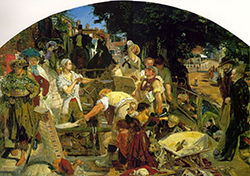 Painting by Ford Madox Brown: Work is generally considered to be his most important achievement. It exists in two versions. The painting attempts to portray, both literally and analytically, the totality of the Victorian social system and the transition from a rural to an urban economy. Brown began the painting in 1852 and completed it in 1865, when he set up a special exhibition to show it along with several of his other works. He wrote a detailed catalogue explaining the significance of the picture. The picture depicts a group of so-called "navvies" digging up the road to build an underground tunnel. It is typically assumed that this was part of the extensions of London's sewerage system, which were being undertaken to deal with the threat of typhus and cholera. The workers are in the centre of the painting. On either side of them are individuals who are either unemployed or represent the leisured classes. Behind the workers are two wealthy figures on horseback, whose progress along the road has been halted by the excavations. The painting also portrays an election campaign, evidenced by posters and people carrying sandwich boards with the name of the candidate "Bobus". A poster also draws attention to the potential presence of a burglar. The setting is an accurate depiction of The Mount on Heath Street in Hampstead, London, where a side road rises up above the main road and runs alongside it. Brown made a detailed study of the location in 1852.
Painting by Ford Madox Brown: Work is generally considered to be his most important achievement. It exists in two versions. The painting attempts to portray, both literally and analytically, the totality of the Victorian social system and the transition from a rural to an urban economy. Brown began the painting in 1852 and completed it in 1865, when he set up a special exhibition to show it along with several of his other works. He wrote a detailed catalogue explaining the significance of the picture. The picture depicts a group of so-called "navvies" digging up the road to build an underground tunnel. It is typically assumed that this was part of the extensions of London's sewerage system, which were being undertaken to deal with the threat of typhus and cholera. The workers are in the centre of the painting. On either side of them are individuals who are either unemployed or represent the leisured classes. Behind the workers are two wealthy figures on horseback, whose progress along the road has been halted by the excavations. The painting also portrays an election campaign, evidenced by posters and people carrying sandwich boards with the name of the candidate "Bobus". A poster also draws attention to the potential presence of a burglar. The setting is an accurate depiction of The Mount on Heath Street in Hampstead, London, where a side road rises up above the main road and runs alongside it. Brown made a detailed study of the location in 1852.
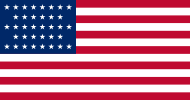 The US flag is modified to have thirty-six stars, reflecting the addition of one new state: Nevada.
The US flag is modified to have thirty-six stars, reflecting the addition of one new state: Nevada.
 The Ku Klux Klan is formed on December 24 in Polanski, Tennessee, by six Confederate veterans. Nathan Bedford Forrest, a former Confederate cavalry general and slave trader, serves as the Klan's first grand wizard or leader-in-chief.
The Ku Klux Klan is formed on December 24 in Polanski, Tennessee, by six Confederate veterans. Nathan Bedford Forrest, a former Confederate cavalry general and slave trader, serves as the Klan's first grand wizard or leader-in-chief.
John Lubbock publishes Prehistoric Times dividing what has previously been understood to be the Stone Age into two parts: the older Paleolithic and the newer Neolithic. In the same book, he also argues that modern Tasmanians and Fuegians are throwbacks to archaic humans.
Sir John William Dawson of McGill University identifies "shells" of huge foraminiferal protozoans. Known as Eozoön or "dawn animal," this find is used as an argument against evolution because it shows a relatively "modern" animal early in the fossil record. It will prove, however, to be a geologically young pseudofossil formed by heat and pressure on limestone.
Paolo Mantegazza publishes Degli Innesti Animali e della Produzione Artificiale delle Cellule (On Animal Grafts and Artificial Cell Production) describing the results of a series of interspecies animal grafts, such as the transplant of a cockspur onto a cow ear. Grafts described include transplants between dogs, frogs and rodents. Mantegazza reports that some grafts decomposed while others became "pathological tumours."
 Rudolf Clausius invents the term ENTROPY to describe the degradation of energy in the closed system.
Rudolf Clausius invents the term ENTROPY to describe the degradation of energy in the closed system.
German zoologist Ernst Haeckel publishes General Morphology of Organisms, the first detailed genealogical tree relating all known organisms, incorporating the principles of Darwinian evolution.
 Ernst Heinrich Haeckel (Häckel) hypothesizes that the nucleus of a cell transmits its hereditary information.
Ernst Heinrich Haeckel (Häckel) hypothesizes that the nucleus of a cell transmits its hereditary information.
 Mendel publishes his work on heredity, Versuche über Pflanzen Hybriden.
Mendel publishes his work on heredity, Versuche über Pflanzen Hybriden.
1866
 Blue Danube Waltz Presented Johann Strauss the younger first presents his Blue Danube Waltz, which later became one of the most popular and familiar works of European music.
Blue Danube Waltz Presented Johann Strauss the younger first presents his Blue Danube Waltz, which later became one of the most popular and familiar works of European music.
On June 13, Congress approves the Fourteenth Amendment to the Constitution, guaranteeing due process and equal protection under the law to all citizens. The amendment also grants citizenship to African-Americans.
 Ernst Heinrich Haeckel (Häckel) first used the term ECOLOGY to describe the study of living organisms and their interactions with other organisms and with their environment.
Ernst Heinrich Haeckel (Häckel) first used the term ECOLOGY to describe the study of living organisms and their interactions with other organisms and with their environment.
H. S. Bidwell (United States) reports controlled pollination in maize.
1867
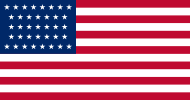 The US flag is modified to have thirty-seven stars, reflecting the addition of one new state: Nebraska.
The US flag is modified to have thirty-seven stars, reflecting the addition of one new state: Nebraska.
The Alaska Purchase resulted in the transfer of Alaska to the United States from the Russian Empire for a total price of $ 7,000,000. The purchase, made at the initiative of United States Secretary of State William H. Seward, gained 586,412 square miles of new United States territory.
Orléans Railway Company employee Peccadeau de l'Isle presents a paper to the French Academy of Sciences on his recent discoveries at Montastruc, including a mammoth carved from a reindeer antler, and two reindeer (found in separate pieces) carved from a mammoth tusk. The finds will eventually be dated at about 13,000 years old.
 Charles Darwin publishes The Variation of Animals and Plants under Domestication, in which he offers his own theory of heredity, which he called the "Provisional Hypothesis of Pangenesis."
Charles Darwin publishes The Variation of Animals and Plants under Domestication, in which he offers his own theory of heredity, which he called the "Provisional Hypothesis of Pangenesis."
Ernst Haeckel publishes Natürliche Schöpfungsgeschichte, subdividing humanity into 12 separate species. He also asserts that evolution consists of 22 phases, the 21st being the "missing link" between apes and humans.
Thomas Henry Huxley publishes "On the Animals which are Most Nearly Intermediate between Birds and Reptiles," arguing that birds are descendants of dinosaurs. This suggestion will not be taken very seriously for another century.
1868
 Louisa May Alcott publishes Little Women.
Louisa May Alcott publishes Little Women.
The Meiji Restoration in Japan (led by samurai from the western clans of Satsuma, Choshu, Tosa, and Hizen) overthrows the feudal shogunate system and initiates Japan's participation in the modern world.
The Impeachment of Andrew Johnson, 17th President of the United States, was one of the most dramatic events in the political life of the United States during Reconstruction, and the first impeachment in history of a sitting United States president.
Three human skulls and other skeletal remains, roughly 30,000 years old, are discovered at a rock shelter called Cro-Magnon (old French for "big hole").
 Louis Ducos du Hauron patents his numerous ideas for color photography based on the three-color principle, including procedures for making subtractive color prints on paper. They are published the following year. Their implementation is not technologically practical at that time, but they anticipate most of the color processes that are later introduced.
Louis Ducos du Hauron patents his numerous ideas for color photography based on the three-color principle, including procedures for making subtractive color prints on paper. They are published the following year. Their implementation is not technologically practical at that time, but they anticipate most of the color processes that are later introduced.
Wallace Clement Ware Sabine becomes the first acoustical engineer and uses acoustic principles to design Boston's Symphony Hall.
 Francis Galton publishes Hereditary Genius. In it he describes a scientific study of human pedigrees from which he concludes that intelligence has a genetic basis.
Francis Galton publishes Hereditary Genius. In it he describes a scientific study of human pedigrees from which he concludes that intelligence has a genetic basis.
1869
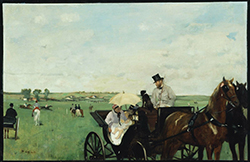 Painting by : At the Races in the Countryside. This painting was one of the first works that Degas sold (in 1872) to Paul Durand-Ruel, the dealer who became the early champion of the Impressionists. It is not only a landscape but also a scene from everyday life and — most of all — a family portrait. The driver of the carriage is Degas's friend Paul Valpin on, who is shown with his wife, a wet nurse, and in the nurse's lap, the couple's son, Henri.
Painting by : At the Races in the Countryside. This painting was one of the first works that Degas sold (in 1872) to Paul Durand-Ruel, the dealer who became the early champion of the Impressionists. It is not only a landscape but also a scene from everyday life and — most of all — a family portrait. The driver of the carriage is Degas's friend Paul Valpin on, who is shown with his wife, a wet nurse, and in the nurse's lap, the couple's son, Henri.
On February 26, Congress sends the Fifteenth Amendment to the Constitution to the states for approval. The amendment guarantees African-American males the right to vote.
Transcontinental Rail Service Begun in the United States On May 10th, at Promontory Point, Utah, a golden rail spike was struck, completing the first transcontinental railroad line.
 Ulysses S. Grant becomes eighteenth president of the United States.
Ulysses S. Grant becomes eighteenth president of the United States.
 Japan colonizes Hokkaido as part of its new nation state.
Japan colonizes Hokkaido as part of its new nation state.
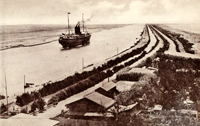 The Suez Canal opened to traffic on 17 November. The canal linked the Mediterranean and the Red Sea. It was 103 miles long and it brought Oriental ports 5,000 miles closer to Europe. Work had begun on the canal in 1859, financed primarily by French investors. The canal increased the strategic importance of Egypt to European powers.
The Suez Canal opened to traffic on 17 November. The canal linked the Mediterranean and the Red Sea. It was 103 miles long and it brought Oriental ports 5,000 miles closer to Europe. Work had begun on the canal in 1859, financed primarily by French investors. The canal increased the strategic importance of Egypt to European powers.
Huxley, Norman Lockyer and others found Nature Magazine, which becomes one of the world's two most important scientific journals. (The other journal is Science.)
ESP Quick Facts
ESP Origins
In the early 1990's, Robert Robbins was a faculty member at Johns Hopkins, where he directed the informatics core of GDB — the human gene-mapping database of the international human genome project. To share papers with colleagues around the world, he set up a small paper-sharing section on his personal web page. This small project evolved into The Electronic Scholarly Publishing Project.
ESP Support
In 1995, Robbins became the VP/IT of the Fred Hutchinson Cancer Research Center in Seattle, WA. Soon after arriving in Seattle, Robbins secured funding, through the ELSI component of the US Human Genome Project, to create the original ESP.ORG web site, with the formal goal of providing free, world-wide access to the literature of classical genetics.
ESP Rationale
Although the methods of molecular biology can seem almost magical to the uninitiated, the original techniques of classical genetics are readily appreciated by one and all: cross individuals that differ in some inherited trait, collect all of the progeny, score their attributes, and propose mechanisms to explain the patterns of inheritance observed.
ESP Goal
In reading the early works of classical genetics, one is drawn, almost inexorably, into ever more complex models, until molecular explanations begin to seem both necessary and natural. At that point, the tools for understanding genome research are at hand. Assisting readers reach this point was the original goal of The Electronic Scholarly Publishing Project.
ESP Usage
Usage of the site grew rapidly and has remained high. Faculty began to use the site for their assigned readings. Other on-line publishers, ranging from The New York Times to Nature referenced ESP materials in their own publications. Nobel laureates (e.g., Joshua Lederberg) regularly used the site and even wrote to suggest changes and improvements.
ESP Content
When the site began, no journals were making their early content available in digital format. As a result, ESP was obliged to digitize classic literature before it could be made available. For many important papers — such as Mendel's original paper or the first genetic map — ESP had to produce entirely new typeset versions of the works, if they were to be available in a high-quality format.
ESP Help
Early support from the DOE component of the Human Genome Project was critically important for getting the ESP project on a firm foundation. Since that funding ended (nearly 20 years ago), the project has been operated as a purely volunteer effort. Anyone wishing to assist in these efforts should send an email to Robbins.
ESP Plans
With the development of methods for adding typeset side notes to PDF files, the ESP project now plans to add annotated versions of some classical papers to its holdings. We also plan to add new reference and pedagogical material. We have already started providing regularly updated, comprehensive bibliographies to the ESP.ORG site.
ESP Picks from Around the Web (updated 06 MAR 2017 )
Old Science

Weird Science

Treating Disease with Fecal Transplantation
Fossils of miniature humans (hobbits) discovered in Indonesia

Dinosaur tail, complete with feathers, found preserved in amber.
Astronomy

Mysterious fast radio burst (FRB) detected in the distant universe.